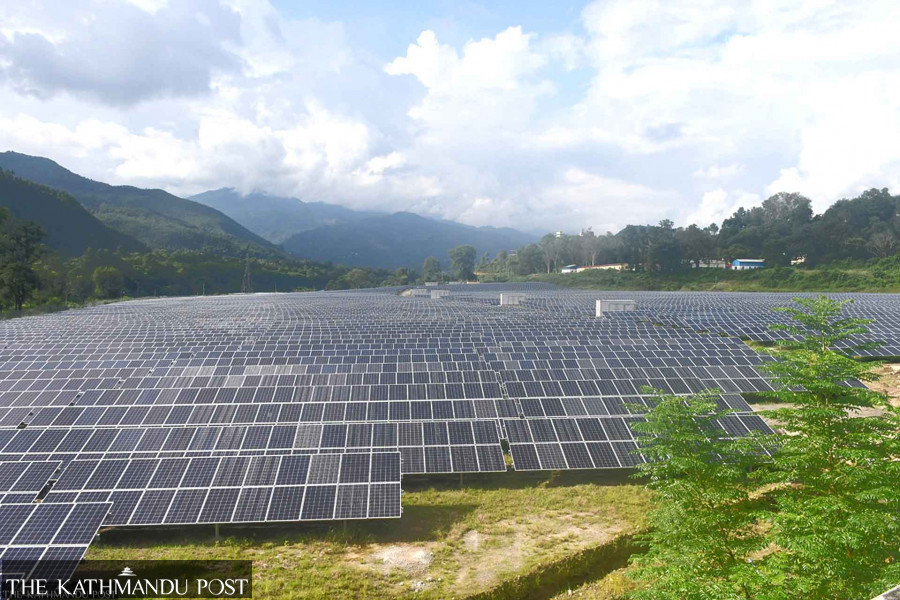National
Six firms to be chosen to supply solar power to grid
This is the first time the NEA is selecting solar companies through competitive bidding. The companies will supply a combined solar power of 90 MW.
Prithvi Man Shrestha
The state-run Nepal Electricity Authority (NEA) is set to select six solar energy generation companies qualified technically and financially to supply grid-connected solar power of around 90 megawatts (MW).
Issuing a tender notice on November 28 last year, the state-owned power utility had invited bids from solar power manufacturers to build grid connected plants and supply up to 100MW of solar energy.
The NEA had also fixed 16 locations around the country where solar plants should be developed.
In late June, the power utility had published the names of the companies that had qualified in terms of technical evaluation and their financial bids were also opened on June 30.
The companies are Pashupati Renewables; Green Infrastructure Pvt Ltd; Arga Bhagabati Ventures Pvt Ltd; Tarai Solar Pvt Ltd; Tarai Energy Pvt Ltd; and Fortune Investment Pvt Ltd.
“All of them passed the financial evaluation too, as all these companies have offered less than the maximum unit price limit set by the NEA at Rs5.94,” said an electricity authority official. “As the combined capacity of generation proposed by them is 90MW, they will all be awarded contracts to build solar plants and supply power.”
The official said the NEA aimed to announce the results of the financial evaluation in the next few days after completing the necessary process. “If the quantum of power that six companies proposed to supply was more than 100 MW, the NEA would be forced to choose from among the companies offering the lowest prices,” he added.
Suresh Bhattarai, spokesperson for the NEA, said the power utility is evaluating the bids and the results would be announced once the process is completed.
This is the first time that the state-owned utility is selecting solar companies through competitive bidding. It is also the first time that the prices of electricity will be determined based on the competition among the companies.
The NEA official said the six companies have submitted eight bids. Two of them have submitted two separate bids.
After being awarded the contract, the companies will build the solar plants and connect the power to the substations at Chanauta, Kapilvastu; Argha, Arghakhanchi; Dhalkebar, Dhanusha; and Seduwa, Parsa.
The bidding process, however, got delayed because of the Patan High Court’s interim order against the NEA plan to buy solar power by capping the price.
In response to a writ petition filed by the Solar Electric Manufacturers Association Nepal, the high court had issued such order by taking into account the claims made by the association that the maximum price of Rs5.94 per unit offered by the NEA would not be profitable for investors who had already made huge investments with the expectation of getting higher prices.
Earlier, the power utility had been signing power purchase agreements with solar power developers at a fixed rate of Rs7.30 as per the Working Procedure on Grid-Connected Alternative Electric Energy Development-2017.
In March 2022, the power utility had decided to cap the maximum rate to be offered to the solar power generators at Rs5.94 per unit. After the Patan High Court in May vacated its earlier interim order issued on March 5, halting the procurement process, the NEA moved ahead to open the technical and financial bids.
NEA said the move to take solar power was aimed at increasing the share of solar power in the energy mix of the country, which is currently insignificant.
Nepal has a long way to go to realise its potential in solar energy with the country so far producing just 44.52 MW from solar power, according to the Ministry of Energy, Water Resources and Irrigation.
The country has a potential to generate around 2,100 MW of solar electricity, according to the Nepal Energy Sector Synopsis Report-2022. Nepal plans to have a certain portion of the energy generated from solar power.
The country also aims to generate a total of 15,000 MW electricity by 2030. Of the total generation, the government wants the contribution of mini- and micro-hydropower, solar, wind, and bio-energy projects from 5 to 10 percent as part of its energy mixing strategy.




 5.55°C Kathmandu
5.55°C Kathmandu







%20(1).jpg&w=300&height=200)






